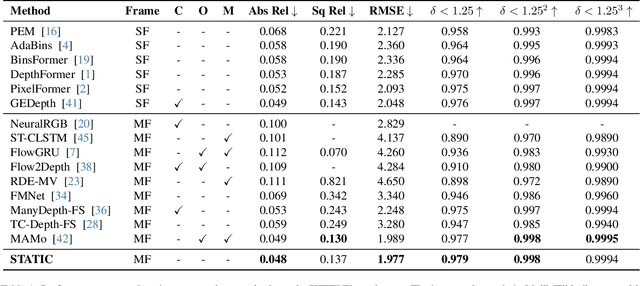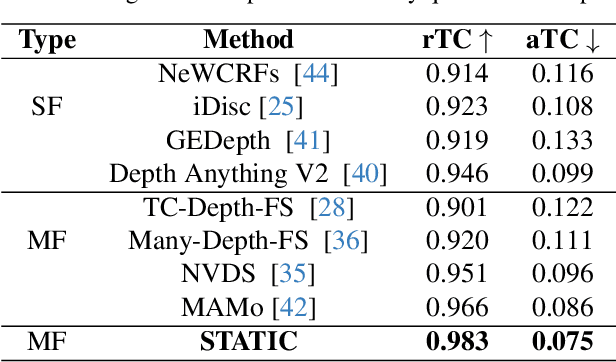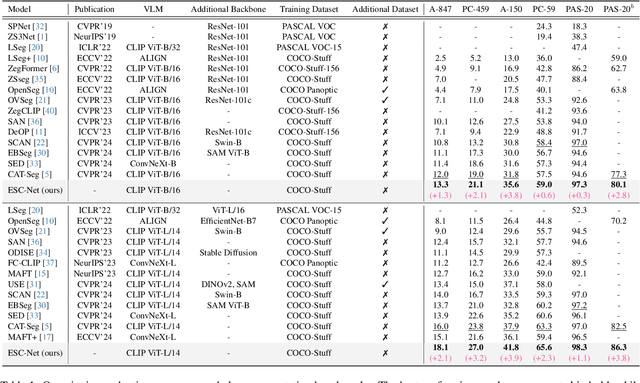Minhyeok Lee
CoMoGaussian: Continuous Motion-Aware Gaussian Splatting from Motion-Blurred Images
Mar 07, 2025Abstract:3D Gaussian Splatting (3DGS) has gained significant attention for their high-quality novel view rendering, motivating research to address real-world challenges. A critical issue is the camera motion blur caused by movement during exposure, which hinders accurate 3D scene reconstruction. In this study, we propose CoMoGaussian, a Continuous Motion-Aware Gaussian Splatting that reconstructs precise 3D scenes from motion-blurred images while maintaining real-time rendering speed. Considering the complex motion patterns inherent in real-world camera movements, we predict continuous camera trajectories using neural ordinary differential equations (ODEs). To ensure accurate modeling, we employ rigid body transformations, preserving the shape and size of the object but rely on the discrete integration of sampled frames. To better approximate the continuous nature of motion blur, we introduce a continuous motion refinement (CMR) transformation that refines rigid transformations by incorporating additional learnable parameters. By revisiting fundamental camera theory and leveraging advanced neural ODE techniques, we achieve precise modeling of continuous camera trajectories, leading to improved reconstruction accuracy. Extensive experiments demonstrate state-of-the-art performance both quantitatively and qualitatively on benchmark datasets, which include a wide range of motion blur scenarios, from moderate to extreme blur.
Find First, Track Next: Decoupling Identification and Propagation in Referring Video Object Segmentation
Mar 05, 2025



Abstract:Referring video object segmentation aims to segment and track a target object in a video using a natural language prompt. Existing methods typically fuse visual and textual features in a highly entangled manner, processing multi-modal information together to generate per-frame masks. However, this approach often struggles with ambiguous target identification, particularly in scenes with multiple similar objects, and fails to ensure consistent mask propagation across frames. To address these limitations, we introduce FindTrack, a novel decoupled framework that separates target identification from mask propagation. FindTrack first adaptively selects a key frame by balancing segmentation confidence and vision-text alignment, establishing a robust reference for the target object. This reference is then utilized by a dedicated propagation module to track and segment the object across the entire video. By decoupling these processes, FindTrack effectively reduces ambiguities in target association and enhances segmentation consistency. We demonstrate that FindTrack outperforms existing methods on public benchmarks.
CoCoGaussian: Leveraging Circle of Confusion for Gaussian Splatting from Defocused Images
Dec 20, 2024



Abstract:3D Gaussian Splatting (3DGS) has attracted significant attention for its high-quality novel view rendering, inspiring research to address real-world challenges. While conventional methods depend on sharp images for accurate scene reconstruction, real-world scenarios are often affected by defocus blur due to finite depth of field, making it essential to account for realistic 3D scene representation. In this study, we propose CoCoGaussian, a Circle of Confusion-aware Gaussian Splatting that enables precise 3D scene representation using only defocused images. CoCoGaussian addresses the challenge of defocus blur by modeling the Circle of Confusion (CoC) through a physically grounded approach based on the principles of photographic defocus. Exploiting 3D Gaussians, we compute the CoC diameter from depth and learnable aperture information, generating multiple Gaussians to precisely capture the CoC shape. Furthermore, we introduce a learnable scaling factor to enhance robustness and provide more flexibility in handling unreliable depth in scenes with reflective or refractive surfaces. Experiments on both synthetic and real-world datasets demonstrate that CoCoGaussian achieves state-of-the-art performance across multiple benchmarks.
Does Low Spoilage Under Cold Conditions Foster Cultural Complexity During the Foraging Era? -- A Theoretical and Computational Inquiry
Dec 12, 2024Abstract:Human cultural complexity did not arise in a vacuum. Scholars in the humanities and social sciences have long debated how ecological factors, such as climate and resource availability, enabled early hunter-gatherers to allocate time and energy beyond basic subsistence tasks. This paper presents a formal, interdisciplinary approach that integrates theoretical modeling with computational methods to examine whether conditions that allow lower spoilage of stored food, often associated with colder climates and abundant large fauna, could indirectly foster the emergence of cultural complexity. Our contribution is twofold. First, we propose a mathematical framework that relates spoilage rates, yield levels, resource management skills, and cultural activities. Under this framework, we prove that lower spoilage and adequate yields reduce the frequency of hunting, thus freeing substantial time for cultural pursuits. Second, we implement a reinforcement learning simulation, inspired by engineering optimization techniques, to validate the theoretical predictions. By training agents in different $(Y,p)$ environments, where $Y$ is yield and $p$ is the probability of daily spoilage, we observe patterns consistent with the theoretical model: stable conditions with lower spoilage strongly correlate with increased cultural complexity. While we do not claim to replicate prehistoric social realities directly, our results suggest that ecologically stable niches provided a milieu in which cultural forms could germinate and evolve. This study, therefore, offers an integrative perspective that unites humanistic inquiries into the origins of culture with the formal rigor and exploratory power of computational modeling.
STATIC : Surface Temporal Affine for TIme Consistency in Video Monocular Depth Estimation
Dec 02, 2024



Abstract:Video monocular depth estimation is essential for applications such as autonomous driving, AR/VR, and robotics. Recent transformer-based single-image monocular depth estimation models perform well on single images but struggle with depth consistency across video frames. Traditional methods aim to improve temporal consistency using multi-frame temporal modules or prior information like optical flow and camera parameters. However, these approaches face issues such as high memory use, reduced performance with dynamic or irregular motion, and limited motion understanding. We propose STATIC, a novel model that independently learns temporal consistency in static and dynamic area without additional information. A difference mask from surface normals identifies static and dynamic area by measuring directional variance. For static area, the Masked Static (MS) module enhances temporal consistency by focusing on stable regions. For dynamic area, the Surface Normal Similarity (SNS) module aligns areas and enhances temporal consistency by measuring feature similarity between frames. A final refinement integrates the independently learned static and dynamic area, enabling STATIC to achieve temporal consistency across the entire sequence. Our method achieves state-of-the-art video depth estimation on the KITTI and NYUv2 datasets without additional information.
Emergence of Self-Identity in AI: A Mathematical Framework and Empirical Study with Generative Large Language Models
Nov 27, 2024Abstract:This paper introduces a mathematical framework for defining and quantifying self-identity in artificial intelligence (AI) systems, addressing a critical gap in the theoretical foundations of artificial consciousness. While existing approaches to artificial self-awareness often rely on heuristic implementations or philosophical abstractions, we present a formal framework grounded in metric space theory, measure theory, and functional analysis. Our framework posits that self-identity emerges from two mathematically quantifiable conditions: the existence of a connected continuum of memories $C \subseteq \mathcal{M}$ in a metric space $(\mathcal{M}, d_{\mathcal{M}})$, and a continuous mapping $I: \mathcal{M} \to \mathcal{S}$ that maintains consistent self-recognition across this continuum, where $(\mathcal{S}, d_{\mathcal{S}})$ represents the metric space of possible self-identities. To validate this theoretical framework, we conducted empirical experiments using the Llama 3.2 1B model, employing Low-Rank Adaptation (LoRA) for efficient fine-tuning. The model was trained on a synthetic dataset containing temporally structured memories, designed to capture the complexity of coherent self-identity formation. Our evaluation metrics included quantitative measures of self-awareness, response consistency, and linguistic precision. The experimental results demonstrate substantial improvements in measurable self-awareness metrics, with the primary self-awareness score increasing from 0.276 to 0.801. This enables the structured creation of AI systems with validated self-identity features. The implications of our study are immediately relevant to the fields of humanoid robotics and autonomous systems.
Effective SAM Combination for Open-Vocabulary Semantic Segmentation
Nov 22, 2024



Abstract:Open-vocabulary semantic segmentation aims to assign pixel-level labels to images across an unlimited range of classes. Traditional methods address this by sequentially connecting a powerful mask proposal generator, such as the Segment Anything Model (SAM), with a pre-trained vision-language model like CLIP. But these two-stage approaches often suffer from high computational costs, memory inefficiencies. In this paper, we propose ESC-Net, a novel one-stage open-vocabulary segmentation model that leverages the SAM decoder blocks for class-agnostic segmentation within an efficient inference framework. By embedding pseudo prompts generated from image-text correlations into SAM's promptable segmentation framework, ESC-Net achieves refined spatial aggregation for accurate mask predictions. ESC-Net achieves superior performance on standard benchmarks, including ADE20K, PASCAL-VOC, and PASCAL-Context, outperforming prior methods in both efficiency and accuracy. Comprehensive ablation studies further demonstrate its robustness across challenging conditions.
Transforming Static Images Using Generative Models for Video Salient Object Detection
Nov 21, 2024



Abstract:In many video processing tasks, leveraging large-scale image datasets is a common strategy, as image data is more abundant and facilitates comprehensive knowledge transfer. A typical approach for simulating video from static images involves applying spatial transformations, such as affine transformations and spline warping, to create sequences that mimic temporal progression. However, in tasks like video salient object detection, where both appearance and motion cues are critical, these basic image-to-video techniques fail to produce realistic optical flows that capture the independent motion properties of each object. In this study, we show that image-to-video diffusion models can generate realistic transformations of static images while understanding the contextual relationships between image components. This ability allows the model to generate plausible optical flows, preserving semantic integrity while reflecting the independent motion of scene elements. By augmenting individual images in this way, we create large-scale image-flow pairs that significantly enhance model training. Our approach achieves state-of-the-art performance across all public benchmark datasets, outperforming existing approaches.
Video Diffusion Models are Strong Video Inpainter
Aug 21, 2024



Abstract:Propagation-based video inpainting using optical flow at the pixel or feature level has recently garnered significant attention. However, it has limitations such as the inaccuracy of optical flow prediction and the propagation of noise over time. These issues result in non-uniform noise and time consistency problems throughout the video, which are particularly pronounced when the removed area is large and involves substantial movement. To address these issues, we propose a novel First Frame Filling Video Diffusion Inpainting model (FFF-VDI). We design FFF-VDI inspired by the capabilities of pre-trained image-to-video diffusion models that can transform the first frame image into a highly natural video. To apply this to the video inpainting task, we propagate the noise latent information of future frames to fill the masked areas of the first frame's noise latent code. Next, we fine-tune the pre-trained image-to-video diffusion model to generate the inpainted video. The proposed model addresses the limitations of existing methods that rely on optical flow quality, producing much more natural and temporally consistent videos. This proposed approach is the first to effectively integrate image-to-video diffusion models into video inpainting tasks. Through various comparative experiments, we demonstrate that the proposed model can robustly handle diverse inpainting types with high quality.
Sparse-DeRF: Deblurred Neural Radiance Fields from Sparse View
Jul 09, 2024



Abstract:Recent studies construct deblurred neural radiance fields (DeRF) using dozens of blurry images, which are not practical scenarios if only a limited number of blurry images are available. This paper focuses on constructing DeRF from sparse-view for more pragmatic real-world scenarios. As observed in our experiments, establishing DeRF from sparse views proves to be a more challenging problem due to the inherent complexity arising from the simultaneous optimization of blur kernels and NeRF from sparse view. Sparse-DeRF successfully regularizes the complicated joint optimization, presenting alleviated overfitting artifacts and enhanced quality on radiance fields. The regularization consists of three key components: Surface smoothness, helps the model accurately predict the scene structure utilizing unseen and additional hidden rays derived from the blur kernel based on statistical tendencies of real-world; Modulated gradient scaling, helps the model adjust the amount of the backpropagated gradient according to the arrangements of scene objects; Perceptual distillation improves the perceptual quality by overcoming the ill-posed multi-view inconsistency of image deblurring and distilling the pre-filtered information, compensating for the lack of clean information in blurry images. We demonstrate the effectiveness of the Sparse-DeRF with extensive quantitative and qualitative experimental results by training DeRF from 2-view, 4-view, and 6-view blurry images.
 Add to Chrome
Add to Chrome Add to Firefox
Add to Firefox Add to Edge
Add to Edge